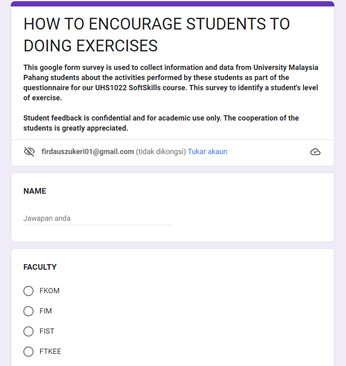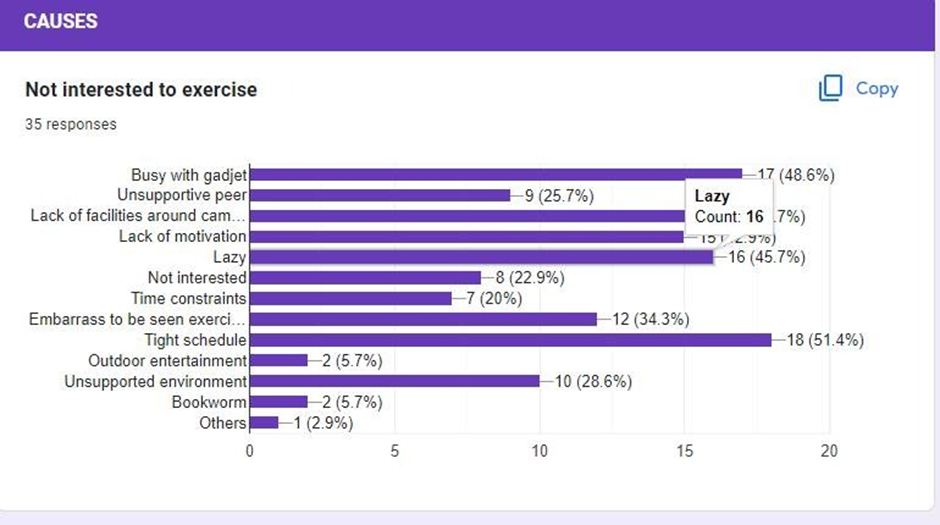REPORT FOR THIS RESULT
1.0 INTRODUCTION
This soft skill course (UHS1022) exposes students to Soft Skills that are very important in positive personality development and prepares them to become professional leaders in the future. Therefore, this course aims to form well-rounded or holistic students who have awareness, good morals and responsibility in self-management, social relationships with other people and the community and also the environment. To achieve this, the course will focus on teamwork and leadership, spiritual and emotional intelligence, lifelong learning, critical thinking, problem solving, manners and positive values. At the end of this course, students will be more resilient spiritually, emotionally, intellectually, and socially to face any challenge in their lives.
In this course we were given the task of studying an issue that often occurs in daily life, under the task of "Current issue discovery (CID)". Therefore, our group has chosen to study ways to encourage students to exercise. The target of our study is targeting students at University Malaysia Pahang. In this study we will study and unravel the reason for this problem among students.
2.0 LITERATURE VIEW
In this chapter we will discuss some aspects of how to get students interested in exercise. Exercise is body movement performed repeatedly in a planned and structured manner aimed at increasing or maintaining one or more components of physical fitness. Exercise also involves the use and production of a lot of labor. In addition, exercise can also provide various advantages for our body's health.
One of the ways we can take care of our health is by exercising. Many medical experts say that exercise is one of the medicines that is not only easy, but also very effective in treating and controlling various health problems. This is because, the older we get, the higher the risk of getting diseases. Therefore, make exercise a 'daily routine' to take care of your health.
There are several advantages of exercise, namely those who are active and exercise regularly, have a lower death rate than those who are inactive because the body of a person who exercises diligently has a heart or a healthier level of health than someone who is lazy to exercise. Exercise has been found to be effective in improving health, especially for those with diseases and problems such as heart disease, diabetes, obesity, hypertension and osteoporosis. Exercise should be made a component of a healthy lifestyle and made a part of daily life practice. Exercise is an activity that needs to be planned, repeated and shaped according to individual needs and abilities.
In this study we have defined three objectives. The first objective is to identify the level of student interest in exercise activities. Next, to study the reasons why students are not interested in exercising. The last objective is to get students interested in exercise.
In addition, we have also listed some issues that can be raised from the title we are studying. Among the issues raised are students who are lazy to exercise. The reason why students are lazy to exercise is because students think that exercise will make us feel tired and the body will feel sick. In addition, there is also the issue of students not being interested in exercise, this is because students think exercise is just a waste of their time. The next issue is about gadgets, this is because students are too obsessed with social media and video games which are more interesting than exercise. The fourth issue is that the schedule is too busy for students. This is because the students cannot manage their time well. Finally, students prioritize academics over exercise. This happens because parents who have educated their children since childhood to pursue academic achievements in order to have a bright future.
Here are listed some of the questions that have been raised based on the issues that have been selected from the search articles of each group member. This question is constructed to ensure that what is to be studied is accurate with the objective of our study. It was explained that the questionnaire that was constructed was not used to be used as a question in the questionnaire that was distributed online, it was only used to identify which questions were suitable to be used as content in the questionnaire. Among the questions raised is, "how can a student organize their daily schedule so as to be able to stabilize learning time and time for leisure?". The solution that can be explained based on this question is that students should be wise in managing the time between studies and sports in order to be balanced. In addition, the question raised is "what causes parents not to support their children being active in sports?". The solution that can be explained based on this question is that parents need to look far ahead for their children's achievement. 2 academic and co-curricular elements need to move in line or balance to be able to produce excellent people. Next, the question raised is "how to limit the time spent playing gadgets on a student?". The solution that can be explained based on this question is that parents need to educate by controlling their children who are still students to use their gadgets healthily. Education from childhood also plays a role in controlling the use of gadgets.
3.0 METHOD
In this chapter, we will discuss research methods to answer the questions that have been presented. This research was conducted by using an online questionnaire distribution method that was distributed among students at University Malaysia Pahang (UMP). This study examines how to get students interested in exercise. This method of distributing questionnaires online is used because of the process to obtain information more easily and relevant to the objectives that have been set. A total of 35 respondents were collected and were willing to answer our questionnaire. The selection of respondents is based on their willingness and availability to answer the questionnaire. Among the characteristics that are taken into account during the selection process of respondents is that they should be from among students at UMP.
https://forms.gle/RdbWEXS G6nx66HcN6

Figure : Results of the percentage of respondents for each faculty who are willing to answer the questionnaire.
http://abdulrazakhusin69.blogspot.com/2012/06/punca-punca-murid-t.html?m=1
http://fazirabtkodir.blogspot.com/2017/12/esei-kumpulanfaktor-yang-masyarakat.html?m=1
http://akujanjirock.blogspot.com/2010/08/204267.html?m=1
https://kheru2006.livejournal.com/1889380.html
https://coachbolasepak.wordpress.com/2018/07/29/adakah-malaysia-kekurangan-jurulatih-berkualiti/
http://abdulrazakhusin69.blogspot.com/2012/06/punca-punca-murid-t.html
https://zonbayi.com/sebab-remaja-malas-bersenam/
https://ms.m.wikipedia.org/wiki/Kerohanian
https://ms.m.wikipedia.org/wiki/Khas:History/Kecergasan_fizikal











Comments
Post a Comment